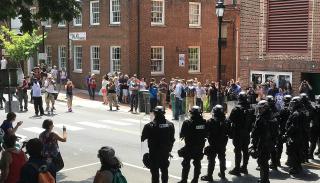
Breadcrumbs navigation
The Idea of Terror: White Supremacist Violence and the Making of Counterterrorism
Examining counterterrorism policy in Germany and the US using novel field and archival data demonstrates how policymakers make sense of the work of counterterrorism, showing that the persistence of structural white supremacy demands that it not be interrogated too deeply, even when policymakers want to do so. In this article, Dr Anna Meier summarises her research on white supremacist violence and its role in constructing counterterror discourse and policy. Anna's research was funded by a BISA Early Career Small Research Grant (ECSRG), and her summary below outlines how the funding was put to use.
I received a BISA ECSR grant to complete data collection for my first book project, The Idea of Terror: White Supremacist Violence and the Making of Counterterrorism. The manuscript is based on my PhD dissertation, which faced several hiccups due to the COVID-19 pandemic and resulting limitations on travel/fieldwork. Thanks to the BISA grant, I was able to conduct two further research trips to collect material essential to the project.
The Idea of Terror argues that white supremacist violence by non-state actors must be considered in conversation with structural white supremacy within the national security state. It reaches this conclusion by relaxing the assumption that counterterrorism, especially policy that targets white supremacist violence, is primarily a security tool. I contend, instead, that counterterrorism is best understood as a tool of governance, working through the desire to preserve what I call “hegemonic components of national identity”—pieces of identity conceptualisations that become so naturalised as to not merit noticing in day-to-day life, but that nevertheless form the backbone of belonging. Put differently, counterterrorism is a way of preserving sociopolitical hierarchies, grounded in white supremacy, that are foundational to the state.
Most basically, the book is a comparative analysis of efforts against, and understandings of, white supremacist violence in Germany and the United States. Building on fieldwork I undertook with national security elites in Berlin prior to the COVID-19 pandemic, the BISA ECSR grant enabled an additional fieldwork trip to reconnect with old contacts and expand my understanding of the German national security apparatus via interviews with Parteistiftungen staffers.
Parteistiftungen (literally, party foundations) are civil society actors loosely affiliated with political parties that conduct public education. This is a uniquely German institution: ordinary citizens engage regularly, and in significant numbers, with Stiftung programs, which are government-funded but presented as independent. Regardless, Stiftungen are an important component of any German policy conversation. In talking to Stiftung staffers, I collected additional evidence for findings that had turned up in earlier fieldwork—namely, that there is an unwillingness among German elites to discuss structural racism and that this hampers security efforts, including public education, to target the far right.
Furthermore, the BISA grant allowed me to travel to Washington, DC to conduct archival research at the Law Library of Congress. There, I delved into the legal history and Congressional hearings surroundings key pieces of US anti-terrorism legislation passed in the 1990s that remain centerpieces of US counterterrorism today. I found copious evidence that not only did much of the US counterterrorism apparatus originate in immigration legislation, but that policymakers in the mid-1990s understood combating terrorism as the act of controlling nonwhite immigration. Even the Oklahoma City bombing, an act of domestic white supremacist violence, was situated within narratives of international terrorism and positioned, perplexingly, as necessitating an immigration-centric response. The archival material I collected further illustrates the centrality of race and racism in the legal construction of the “terrorist” and underscores the use of counterterrorism as a tool for shaping (and preserving) a singularized identity for the US polity.
Altogether, these two research trips flesh out The Idea of Terror’s core arguments, providing important historical detail in the case of the US and deeper insight into an under-explored aspect of the counterterrorism apparatus in the case of Germany. With these additional data, I am now prepared to finish the manuscript and submit a proposal to publishers. I am exceedingly grateful that BISA has allowed me to pursue the parts of my research design dashed by lockdowns during the COVID-19 pandemic and write the sort of book I had hoped to write when I began my dissertation.
Anna received a BISA Early-Career Small Research Grant to help with this research. You can find out more about all our funding on our funding page. We'll be bringing you details of when Anna's book is released soon.


